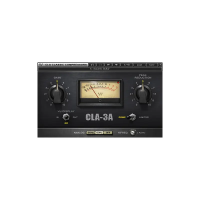Using the L1
The Peak Limiter
Pass audio through the L1.
Listen to the output of the L1.
Set the limiter Threshold by dragging the left triangle (Threshold) down or by rotating the
[DATA/JOG] dial when the CURSOR is on Threshold. Leave the Out Ceiling setting at the
maximum value: 0 dB. When the signal exceeds the threshold, the gain reduction is indicated on
the single Attenuation meter to the right.
Set the threshold about 4–6 dB lower than the peaks in the Threshold meters. The Attenuation
meter displays 4–6 dB of peak limiting.
As the Threshold is pulled down, the output level goes up. To begin with, leave the Out Ceiling set-
ting at 0 dB (the maximum peak output).
Note that the output level is significantly increased. If the threshold is -12 dB, the signal has been
boosted 12 dB (not necessarily recommended). Typically, several dB of limiting is virtually inaudible
and raises the average output signal level enough to improve overall response.
Only the signal above the threshold is limited; signals below the threshold have a constant gain
change determined by the difference between the Threshold and the Out Ceiling. This is how the L1
maximizes the level while maintaining the desired headroom.
Release Time and Attenuation Meters
Adjust the Release time to suit the application: 1 ms for most sources, 3–7 ms for mastering, and as
high as 30 ms for voiceover. The release time controls how fast the L1 recovers to constant gain after
encountering a peak. Distortion or fuzziness can sometimes be reduced by increasing the release
time.
Y56K User Guide
37

